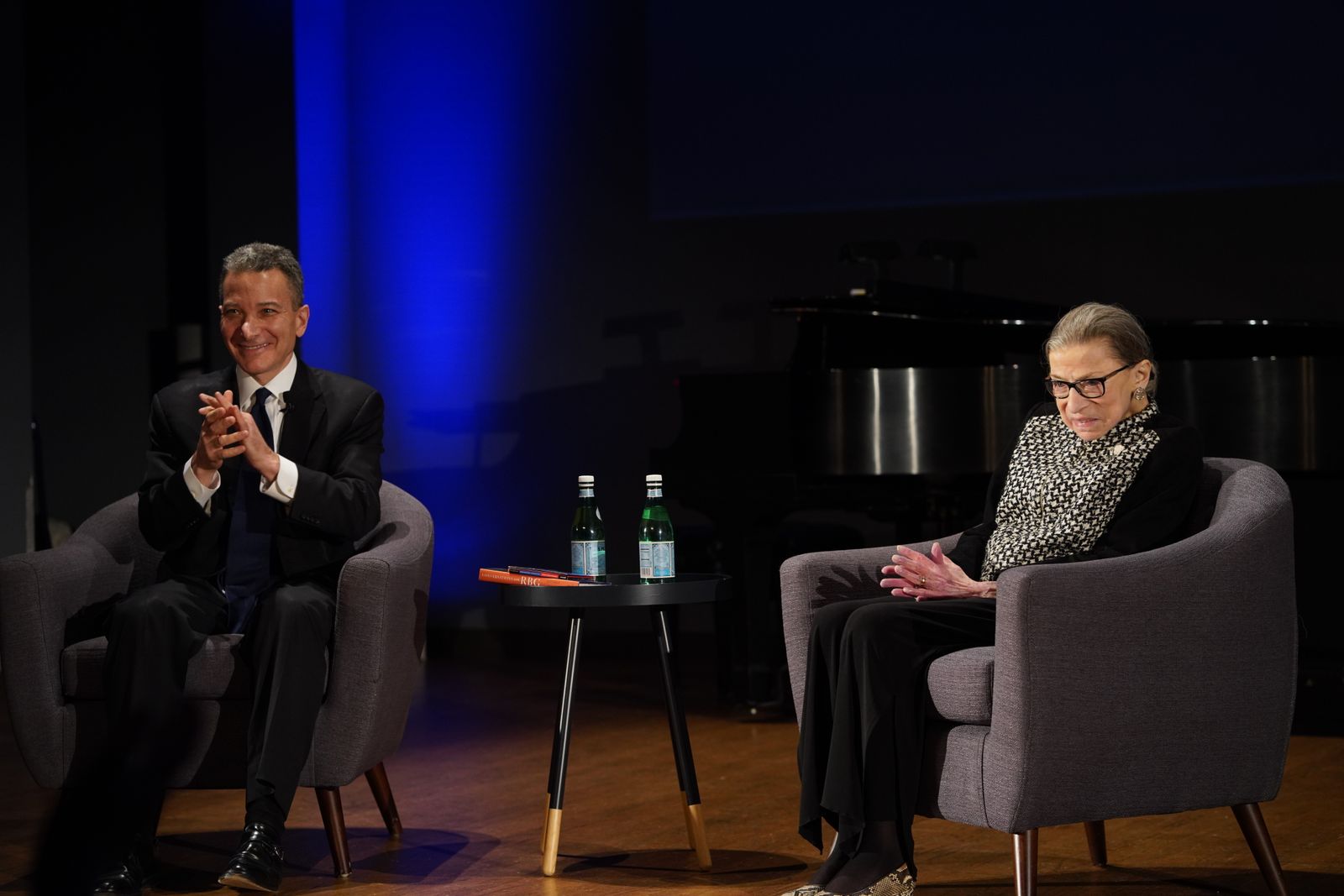There has been plenty of backlash during this administration against what some critics have called “the cult” of RBG, aka, Supreme Court Justice Ruth Bader Ginsburg. Some are critical of the merchandise with the justice’s slight figure silhouetted beneath phrases like “The Notorious RBG,” opining that it hedges on idolatry and risks politicizing the courts in favor of liberal causes at the expense of equal justice. Others wield vicious ad hominem attacks on Ginsburg simply because she stands between them and their wish for a wholly conservative bench.

But such fuss risks mistaking RBG, The Symbol, for Ruth Bader Ginsburg, The Woman. Thankfully, American soprano-composer Patrice Michaels has managed to both immortalize and humanize her mother-in-law in the song cycle, The Long View: A Portrait of Ruth Bader Ginsburg in Nine Songs.
With Ginsburg in the audience, Michaels performed her work at the National Museum of Women in the Arts Performance Hall in a concert sponsored by the National Constitution Center to celebrate the release of a new book, Conversations with RBG, by the Center’s president and CEO, Jeffrey Rosen. Michaels premiered the work at the same venue earlier this year, also with the justice in attendance, still recuperating from lung cancer surgery.
Michaels’ song cycle affords us a glimpse into the inner life of a woman who claims her success is as much due to her own hard work as to her good fortune to have been “born at the right time,” as Ginsburg told Rosen in a post-concert interview before a live audience.
Drawing on actual events, letters, and the imagination of both Ginsburg and Michaels, The Long View explores formative moments in the justice’s life and her impact on all of ours as Americans. After the performance, Michaels explained to me how a song she’d composed as an 80th birthday gift for Ginsburg, the mother of Michaels’ husband James, eventually grew into an entire song cycle.
“I thought if I could find enough material about the other people in her life that could describe her, that it could be a good portrait of her,” Michaels told me.
Their collaboration included culling Ginsburg’s personal, unpublished papers and mementos, as well as her public papers held at the Library of Congress for the most evocative moments. What emerges in the song cycle is a tripartite theme to Ginsburg’s life: Work hard. Be kind. Do not let negative emotions blow you off course.
“Anger is unproductive,” Ginsburg told Rosen. “Better to work hard and find a way around a problem.”

The compositional structure of the song cycle is Sondheim meets Schubert. A mixture of jazzy, late 20th Century patter combines with early 19th Century phrasing to shape moments in Ginsburg’s life, however ordinary they might have seemed at the time, into vivid portraits of quintessential scenes from American history. In “The Elevator Thief,” repeated calls to Ginsburg from her son’s school principal to complain about the boy’s behavior might seem insignificant, yet it reflects classic mid-20th Century attitudes. When the busy working mother Ginsburg has to remind the man that her son “has two parents,” rather than disturb the working father, the calls just stop altogether.
The original song, “Anita’s Story,” sits at the heart of the cycle. It is Michaels’ setting of a letter from Anita Escudero, a typist tasked with transcribing the young Ginsburg’s law briefs, who experiences an awakening about the fullness of her human rights. “I am not your woman,” Anita declares to her husband, “I am a person!”
Michaels’ performance was reverent but not cloying. Her sound was warm and straight forward, like the work’s eponymous subject. Accompanying Michaels was the Inscape Chamber Orchestra with Andrew Harley at the piano and Kuang-Hao Huang conducting. The ensemble’s playing was clear, and benefited from skillful orchestration by Peter Labella.
With the woody depth of his clarinet, Evan Ross Solomon intoned the men in Ginsburg’s life, evoking by turns her father Morris Bader’s stern but loving support, and her husband Marty Ginsburg’s unfailing humor and adoration, as well as other male perspectives sometimes less than generous, such as the musings of Supreme Court associate justice, William O. Douglas, that one day women might be just capable enough to be law clerks.
Ginsburg claimed to Rosen that when she entered law school, despite being one of only a handful of women to do so, attitudes toward women already were shifting. She was prepared to successfully ride the currents of change and credits her family for the advice and support they unfailing gave her, including posthumously through their enduring wisdom imparted to Ginsburg.
The cycle’s second song is based on an imaginary letter to a young Ginsburg at sleep-away camp. Michaels said she called upon Ginsburg to ensure the song elicited authenticity. “Making up a letter about her mother as if her mother had written it was a really bold move. I wanted to be sure I got it right.”
“Celia: An Imagined Letter from 1949” advises the young Ruth to “be independent, prepare for difficulty, and stand on your own two feet” before closing with a reference to soup that needs attention as it cooks on the stove.
In the chronology of Ginsburg’s actual life, her mother died of cancer not long after this imagined scene takes place. Michaels’ choice to root the prescient, if imagined, counsel for the nation’s future second female Supreme Court jurist in quotidian matters such as soup for dinner adds to the “every man and woman” quality of Ginsburg’s story.
As we see from photos projected on the wall behind the stage, and as we hear while the stories unfold, the Baders were not poor, but neither were they of significant means. What they had in abundance was love, grit, and a knack for carrying on despite painful loss. To wit, when Ginsburg was two, her six-year-old sister died of meningitis, devastating her family and forming what Ginsburg told Rosen was the bedrock of her empathy for others.
Although originally scored for solo soprano, an alternate ending for the cycle is for a Greek chorus of sorts to sing-chant various dissenting opinions issued by Ginsburg. In this performance, the Aspen Institute’s Eric L. Motley announced each dissent, then The Capital Hearings chanted them out superbly, taking their task seriously, without sounding rote.
In the final line of text to the score, Ginsburg is asked about the role of a Supreme Court Justice in light of “polarization,” a question she dodges in favor of a bel canto vocal flourish.
“I chose not to engage in wordplay, but because [Ginsburg] has always said her alternate career is as a grand opera diva, I thought it was a perfect opportunity to answer with that other side of herself,” said Michaels.
Indeed, Ginsburg told Rosen that when she gets stuck in an “unproductive” emotion, she transcends it through listening to classical music, escaping to a place beyond understanding before returning to the issue at hand.
Although well-wrought and enjoyable, whether The Long View will in time be considered a vocal recital classic is perhaps of a matter of less consideration than its relevance for the deeply personal context it adds to important US history.
Running time: Song cycle, 35 minutes; post-performance conversation, approximately 1 hour and 15 minutes.
The Long View: A Portrait of Ruth Bader Ginsburg in Nine Songs sponsored by The National Constitution Center was performed at the National Museum of Women in the Arts, 1250 New York Ave NW, Washington, DC on Tuesday, December 17, 2019, at 6:00 PM. For more information about The National Constitution Center Traveling America’s Town Hall Programs and other events, go online.




